
Michael A. Kodysz submitted these numismatic thoughts relating to two holiday television specials. Thanks!
-Editor
Chocolate coins, the Jefferson Nickel, and the Star of Bethlehem
Two Rankin/Bass Christmas specials, The Little Drummer Boy (1968) and Nestor the
Long-Eared Christmas Donkey (1977), were favorites of mine as a child. While re-
watching them again last Christmas season, several anachronisms stood out. With the
benefit of childhood ignorance back in the 70s, I enjoyed these shows unperturbed by
inaccuracies of historical detail. But now as a 50-something adult possessing a basic
knowledge of history, these inexactitudes irritate me perhaps more than they should —
after all, Rankin/Bass productions exist not for the purpose of teaching history, but as
quasi-religious fantasy entertainment for children.
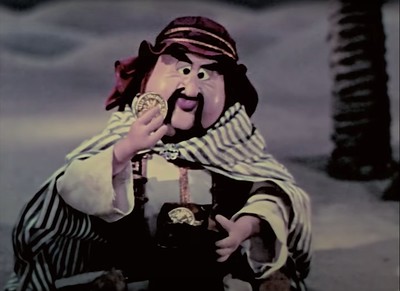
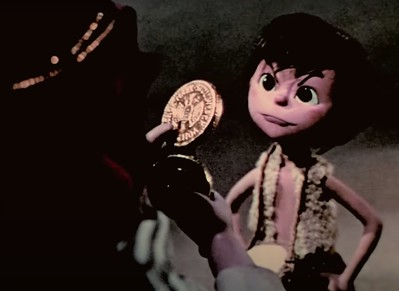
The overarching anachronism of The Little Drummer Boy, which takes place during the
nativity of Jesus, is that the Roman province of Judaea is populated by modern ethnic
stereotypes. Here the stop-motion puppet characters are dressed in attire more
appropriate to Ali Baba and the Forty Thieves than to Jews from the time of Herod the
Great. One example is the greedy, hook-nosed Ben Haramed, the leader of a caravan
of traveling performers, who kidnaps an orphaned drummer boy named Aaron and
forces him to join his troupe. Ben Haramed wears a lavishly embroidered vest
resembling a yelek, and his sidekick Ali of Arabia sports a hat called a fez. Never mind
that both the yelek and the fez originated in Ottoman Turkey around the 17th century
A.D.
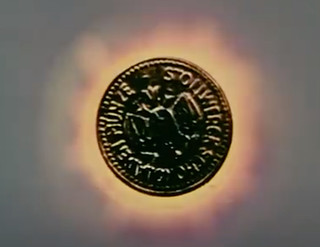 A numismatic connection occurs in The Little Drummer Boy when Ben Haramed bursts
Tevya-like into song and dance, a kind of
A numismatic connection occurs in The Little Drummer Boy when Ben Haramed bursts
Tevya-like into song and dance, a kind of If I Were a Rich Man for shifty desert
nomads. During the song, Ben Haramed reaches into his bag of shiny gold coins and
flings one of them high into the air. However, the coin's perfectly round and regular
shape evinces no attempt by the animators to suggest the high relief and irregular
contours typical of an ancient coin. On first impression this prop appears to be a modern
milled coin; but upon closer inspection of a still frame its true nature is revealed. Despite
low resolution and backlighting, the shape of an eagle can be seen on the coin's
surface. The design of the eagle is rendered in the post-World War II modernist style
symbolic of the Federal Republic of Germany, commonly known as West Germany.
Around the eagle a legend is discernible: STOLLWERCK SCHOKOLADE MUNZE,
which translates as Stollwerck chocolate coin. These same chocolate coins are shown
more clearly in a later scene, in which Ben Haramed sells Aaron's camel companion for
the price of a bag of gold. These coins are shown from various angles as Ben fondles
them greedily. In one frame the literal other side of the coin is visible, stamped with the
number ten.
Ben Haramed's coin, then, is really a child's confectionary treat wrapped in gold-
colored foil and made by the Cologne-based chocolate manufacturer Stollwerck.
Founded in 1839 by Franz Stollwerck, the company has a storied history, and the brand
continues to produce chocolate today. During the 1960s, chocolate coins exported by
Stollwerck would have been cheap and readily available in Japan where the
Rankin/Bass animations were filmed. It seems logical, then, that the animators decided
to use these shiny gold-colored coins as convenient and cost-effective stand-ins for
the real thing. Given that the film was made for children, the use of chocolate coins is
appropriate — perhaps these would have been the only money available for some
children of the target age range to play with. Probably several denominations, each a
different size, were sold together as a set. The animators likely selected the ten
because it fit comfortably in the puppets' hands.
It seems safe to surmise that the animators, working during the era of low-resolution
progressive-scan TVs with relatively small screens, did not anticipate that viewers would
ever be able to discern much detail on the coin's surface. Only still frames on an HD
monitor and research on Google have enabled me to positively identify these coins as
the product of Stollwerck chocolates, which to the best of my knowledge is the first time
this fact has been discovered outside of the animation studio itself. The Stollwerck
company has been mute on the subject since I reached out to them via email several
months ago.
Several of the set pieces and puppets used in The Little Drummer Boy were apparently
reused in Nestor the Long-Eared Christmas Donkey, which premiered 11 years later.
But commonalities between the two films go beyond shared production assets. For
example, in both tales the main protagonist journeys across the desert, following the
Star of Bethlehem to the nativity of Jesus. Each witnesses the divine infant lying in the
manger. Within their individual stories, both Aaron the drummer boy and Nestor the
donkey are destined to assist the Holy Family: Nestor transports the pregnant Mary to
Bethlehem on his back, and Aaron plays a calming, rhythmic tune on his drum for the
infant Jesus as Mary and Joseph look on. Another commonality: in both films, coins
change hands when an animal is sold.
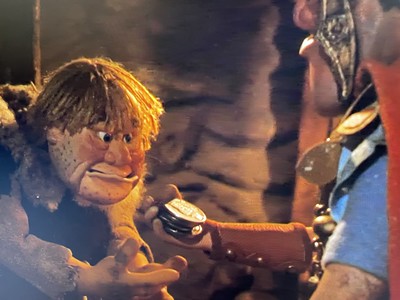
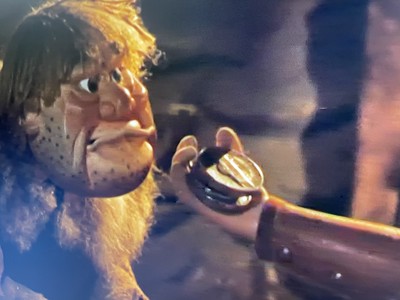
However, unlike The Little Drummer Boy's chocolate coins, in Nestor, real coins are
used. In a scene in which Nestor's owner Olaf is forced to sell him to the Romans along
with several other animals, Olaf and a soldier discuss their price in silver. During the
transaction, Olaf is shown holding a stack of silver coins while the soldier hands him
another. On the face of the coin held by the soldier, the shape of Monticello, Thomas
Jefferson's home, is easy to discern, making it obvious that these are U.S. Jefferson
nickels and not actually silver. As in The Little Drummer Boy, there is no attempt here to
imitate the look of a genuine ancient coin. Jefferson nickels were chosen as stand-ins
for the denarius, the standard silver denomination in the Roman empire during the reign
of Augustus. Probably for similar reasons that chocolate coins were used in The Little
Drummer Boy, nickels were cheap, readily available, and of the appropriate size to fit
the puppets' hands.
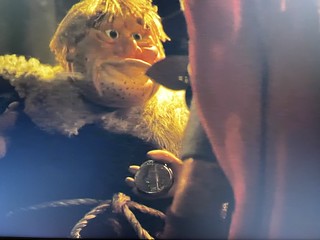 Beyond this I believe that the animators must have chosen the Jefferson nickel,
specifically out of all modern coins of comparable size, because its relative chunkiness,
smooth edge, and mellow color reminiscent of toned silver help it to appear sufficiently
Beyond this I believe that the animators must have chosen the Jefferson nickel,
specifically out of all modern coins of comparable size, because its relative chunkiness,
smooth edge, and mellow color reminiscent of toned silver help it to appear sufficiently
ancient. Indeed, the Jefferson nickel lacks some of the telltale features of many
modern coins they might have considered instead, such as the Roosevelt dime with its
reeded and copper-colored edge. Perhaps of equal importance in determining the use
of the Jefferson nickel as a prop in Nestor is that the reverse bears a frontal image of
Monticello. It was Jefferson himself who designed Monticello in a neoclassical style
inspired by the architectural forms of ancient Greece and Rome.
The most prominent of these forms on the building's façade are visible on the nickel.
These include a portico with steps leading up to it and two rectangular wings extending
on either side. Over the portico is a triangular pediment supported by columns, and
above this pediment rises a dome. The central part of Monticello's structure is modeled
after the Pantheon in Rome, a building which dates to the reign of Emperor Hadrian
around A.D. 126, more than a century after the nativity. Nonetheless, the animators
must have certainly felt that the image of Monticello lent an authentic but sufficiently
generic Roman look to the coins. They therefore hid the more recognizable portrait of
Jefferson by deliberately orienting the coins in the puppets' hands so that the reverses
showing Monticello faced upward toward the camera.
Many anachronisms in The Little Drummer Boy and Nestor the Long-Eared Christmas
Donkey are based on modern ethnic stereotypes. But the use of modern coins as props
in these films, whether made from nickel or chocolate, appears to have been a purely
practical matter for the animators. For myself as a twenty-first century 50-something
adult, a member of Rankin/Bass's original target audience now grown up, these
numismatic easter eggs are seasonal gifts that await discovery and invite
identification.
THE BOOK BAZARRE
BIBLE LORE AND THE ETERNAL FLAME—
Kenneth Bressett's latest book is a numismatic and archaeological trip through Biblical times, a roadmap of the Old and New Testaments that explores history through coins. Beautifully illustrated and entertainingly written by a master of the craft. Order your copy online
at
Whitman.com
, or call 1-800-546-2995.
Wayne Homren, Editor
The Numismatic Bibliomania Society is a non-profit organization
promoting numismatic literature. See our web site at coinbooks.org.
To submit items for publication in The E-Sylum, write to the Editor
at this address: whomren@gmail.com
To subscribe go to: https://my.binhost.com/lists/listinfo/esylum
Copyright © 1998 - 2024 The Numismatic Bibliomania Society (NBS)
All Rights Reserved.
NBS Home Page
Contact the NBS webmaster
|







